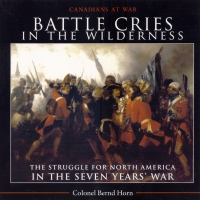| ________________
CM . . . . Volume XVIII Number 22 . . . . February 10, 2012
excerpt:
The Seven Years War, often known as The French and Indian War in North America, was a struggle between Britain and France for control of the continent. It was also part of a much larger struggle between these two European powers that took place in India, Europe and some of the seas and oceans of the world. Fought between 1754 and 1760*, it is sometimes regarded as the first world war. As a result of the war, all of North America, including New France, became a British possession. The northern half of the continent eventually became the Dominion of Canada while the colonies to the south became the United States of America. The war is, therefore, a vital part of Canadian history. Battle Cries in the Wilderness could be used for classroom support or for recreational reading. Battle Cries, which tells the story of this war in North America, is a good history book, well written, historically accurate and interesting. In the author's skilful hands, the reader almost becomes a witness to the struggle, much as one does when observing a traffic accident. The book has five chapters of roughly twenty pages each and is well suited to the intended readership. It has an index and selected readings. It also has an excellent map of the North American Theatre of Operations 1754-1760 which is very helpful. It contains many functional black and white illustrations all through the book. In addition, there are numerous sidebars which provide interesting bits of historical information. These are titled Did You Know?, Key Facts, Shocking Fact, and Shocking Reality. One Did You Know? gives a brief biography of the Marquis de Vaudreuil, a governor of New France. The war in North America was not fought in the conventional European way with massed troops facing each other and firing volley after volley until one side fled or gave up. Much of the conflict took place between irregular troops (militia, rangers and native) skilled in fighting in the woods. Ambushing the enemy, fighting behind trees and then retreating before the enemy could fight back was far more successful in the woods of eastern North America than the European style of battle. Considerable attention in Battle Cries is paid to the native way of warfare, the style mentioned above. Both the English and the French used native allies. Their style of fighting would today be called guerrilla warfare. It was successful because the natives were "physically active, fierce in manner, skilful in the use of weapons, and capable of great guile and stealth in combat." Many of the French and English troops were young conscripts with little, or no, battle experience and unsuited to warfare in the woods. They also wore brightly coloured uniforms that made them easy targets. Some often died horrible deaths at the hands of native warriors who liked to torture and scalp their victims. Author Bernd Horn is a professor of history at the Royal Military College in Kingston, ON. He has written, co-authored and helped edit thirty books on military history including Men of Steel: Canadian Paratroopers In Normandy, 1944. Recommended. Thomas F. Chambers, a retired college teacher, lives in North Bay, ON. * The war officially ended with the Treaty of Paris in 1763.
To comment
on this title or this review, send mail to cm@umanitoba.ca.
Copyright © the Manitoba Library Association. Reproduction for personal
use is permitted only if this copyright notice is maintained. Any
other reproduction is prohibited without permission.
NEXT REVIEW |
TABLE OF CONTENTS FOR THIS ISSUE
- February 10, 2012.
AUTHORS |
TITLES |
MEDIA REVIEWS |
PROFILES |
BACK ISSUES |
SEARCH |
CMARCHIVE |
HOME |
